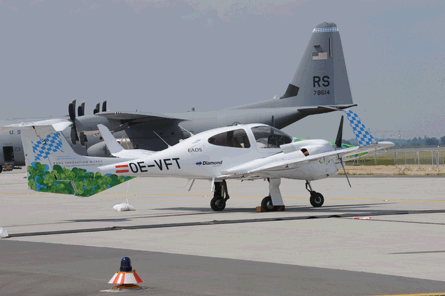Airbus parent EADS is to make an environmental breakthrough at ILA by flying an aircraft powered by a biofuel composed purely of algae.
The daily flights will be conducted using a Diamond DA42 New Generation light twin powered by Austro Engine AE300s.
As a result of algae's higher energy content, fuel burn will be 1.5 litres per hour (0.4USgal/h) lower than if conventional Jet-A1 fuel were used, says EADS, adding: "Only relatively minor modifications and adjustments had to be made to the aircraft's engines."
EADS estimates that algae-based biofuel contains one-eighth the level of hydrocarbons in kerosene derived from crude oil, and releases 40% less nitrogen oxide and about 98% less sulphur dioxide than conventional Jet-A1 fuel.
 |
|---|
© Billypix |
Algae has long been touted as a potential salve to aviation's carbon concerns on the grounds that its cultivation - which does not compete with food production - can be achieved on poor quality land using non-potable water or even seawater. Furthermore, it reproduces rapidly and, by EADS's calculations, creates "at least 30 times more biomass per cultivation area than rapeseed".
However, the task of reaching scale production is complicated by the high surface area taken up the open ponds in which algae is grown, the specialised technology required for photosynthesis, and difficulties in achieving efficient dewatering.
EADS says that "all necessary technologies to develop the production of biofuel from algae are known, but industrial size and economy require further development" as it is "significantly more expensive" to produce oil from algae than from crude oil.
To overcome this obstacle, EADS has enlisted partners in "a pilot project to develop the necessary industrial infrastructure" for algae-based biofuel production. Led by its Innovation Works research and technology division, the EADS project has received funding support from the Bavarian government and involves Diamond Aircraft, Austro Engines and German cereal-processing institute IGV.
The target is "cost-effective mass production of algae biofuels using industrial quantities of carbon dioxide". EADS estimates that the amount of CO2 released during flight is "about equivalent" to that absorbed during the algae's growth phase, creating the potential for carbon-neutral flights.
The algae oil to be used in the DA42 flying ILA demonstration flights was delivered by Argentina's Biocombustibles del Chubut and refined into biofuel by Verfahrenstechnik Schwedt, of Germany.
Algae biofuel is not yet available in sufficient quantities to power an Airbus A320 narrowbody or even an A318, EADS confirms.
In February, the manufacturer revealed plans to assess the potential of microalgae over a 12-month period in collaboration with Singapore's Agency for Science, Technology and Research. Within these plans, the partners committed to investigate methods of converting the microalgae oil to fuel.
Source: Flight Daily News























